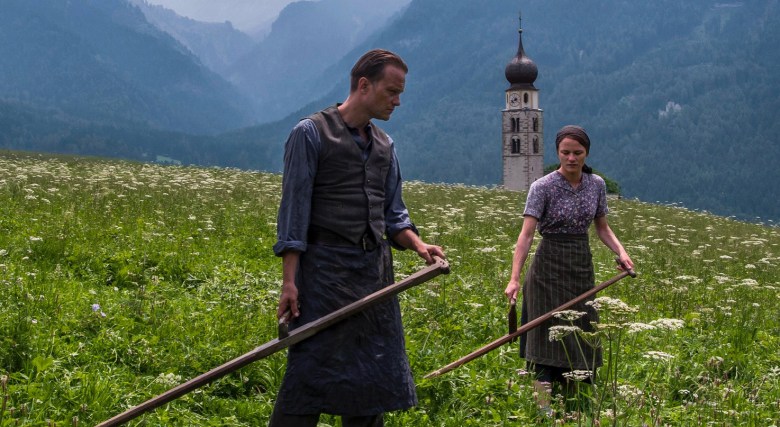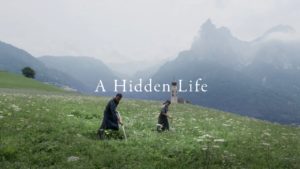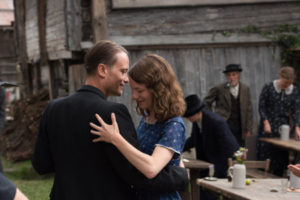
God in the Movies: A Hidden Life of Blessed Franz Jägerstätter
January 17, 2020
 Themes from Theology of the Body are beautifully enfleshed in a recent film about the life and death of the World War II Austrian martyr, Blessed Franz Jägerstätter. A Hidden Life paints a compelling portrait of this devout Catholic and a conscientious objector executed in 1943 for refusing to pledge his loyalty to Adolf Hitler. Jägerstätter was beatified by Pope Benedict XVI in 2007.
Themes from Theology of the Body are beautifully enfleshed in a recent film about the life and death of the World War II Austrian martyr, Blessed Franz Jägerstätter. A Hidden Life paints a compelling portrait of this devout Catholic and a conscientious objector executed in 1943 for refusing to pledge his loyalty to Adolf Hitler. Jägerstätter was beatified by Pope Benedict XVI in 2007.
Among the first images of Franz and his wife are their hands and knees, side by side, tilling the soil of their farm in the stunningly beautiful alpine village of St. Radegund. As they plow, plant and harvest their crops, their hands and arms intertwine effortlessly, almost as one body. This given complementarity of their maleness and femaleness becomes a golden anthropological thread woven throughout the film: the human body does indeed “speak a language.”
Recall that in the biblical vision of the human person, our bodies make visible the invisible mystery of God: He is love. The sacramental love of Franz and Fani, in their words, gestures and glances is a lyrical portrait of Saint John Paul II’s definition of original unity: “man becomes an image of God not so much in the moment of solitude as in the moment of communion….this constitutes the deepest theological aspect of everything one can say about man.”
In Bl. Jägerstätter’s sacrificial witness to his Catholic faith we see a 20th-century image of St. Joseph’s joys and sorrows in living under Herod’s tyranny. It is the reality of his wife’s love and abiding trust in God that allows Frans to persevere. The flashbacks to their family life during Jägerstätter’s imprisonment reminds the audience that before the culture of death enshrined in National socialism entered human history, Franz and Fani truly did enjoy a sacramental unity: they lived in harmony within themselves, with each other, their village, indeed with all creation. The state-sponsored shattering of this world, and with it, God’s plan for peace, social justice and human solidarity, is with great artistry recounted in A Hidden Life.
Director Terrence Malik reworks in this film a key theme from his earlier films, that of an earthly paradise about to be lost. The sublime beauty of the Austrian landscape his camera conveys is a but a foreshadowing of the darkness to come. The peaceful clouds above St. Radegund ominously darken, then open to reveal below the medieval city of Nuremburg, where a Nazi party rally is underway.
A Hidden Life, like most good biographies of the Saints, succeeds because it is unsentimental. In this it brings to mind St. John Paul II’s concern that we never divert our eyes from the consequences of original sin in our lives, and in human history. The film spares none of the cowardice and injustice of the villagers’ reaction to Jägerstätter’s decision not to join them in enlisting in the Nazi army. Malick’s camera neither glamorizes nor glosses over the costly path of discipleship offered to Jägerstätter. Through the reflections of a local Catholic artist painting sentimental scenes of Christ’s life in the Church’s nave, while he and his neighbors make their own accommodations with fascism, Malik forces the audience to ask the penetrating spiritual question, what would we have done as Catholic Christians in that agonizing situation?
If you believe that St. John Paul II’s theological anthropology is indeed a healing balm for a broken world, I urge you to make time to see A Hidden Life.
The Magisterium of the Church makes clear that Catholics are not pacifists, as was Jägerstätter, but at the same time, we must all respect and obey our consciences, rightly informed by Church teaching. The film contains no graphic violence or degrading language. For its luminous artistic, cultural and anthropological qualities, I cannot commend this film highly enough!
St. John Paul II, Theology of the Body, 9:3.
Written by Fr. Tom Wray, Chaplain at Ruah Woods Press
Share